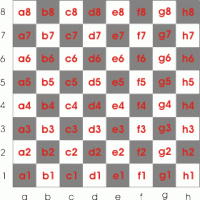
The Language of Chess
All but the most casual chess players are familiar with Algebraic or Standard Notation such as 1. e4 e5 2. Bc4 Nf6 and all serious students of the game are conversant in the Descriptive Notation that is still found in classic chess books: 1. P – K4, P – K4 2. B - QB4, Kt – KB3. But how many players are aware of the great cacophony of voices that have cried out for recognition as The Language of Chess?
There are interesting and sometimes surprising stories behind these two common notations, but there are far more notations that have been invented than just Algebraic and Descriptive. Some of you will at least recognize the name of Forsyth-Edwards Notation (FEN) or Portable Game Notation (PGN) because they are also widely used for different purposes (or purpi as the more educated prefer to write for that plural).
And yet there are more. For example we may choose to describe chess in any of the following: Correspondence Notation, Uedemann Code, Gringmuth Notation, Universal Notation, Universal Chess Notation (different from Universal Notation), Prince Notation, Dynamic Chess Notation, Extended Position Description, Smith Notation, Concise Reversible, the Guy-Blandford-Roycroft code and a Babel of others. Some of these are mainstream in the sense that they are used today for specific purpi (or purposes, if you insist). Others are not mainstream at all and have died a merciful, though generally deserved death.
The desire to create new notations is evidently an insatiable compulsion that afflicts the chess body, as a narcotic afflicts the addict. Chess junkies continue to invent new systems to describe the game. As an example of such an invention-in-progress, the reader is invited to click on this link to discover the crack-high of Steno-Chess.
When faced with an otherwise unordered set of objects, in this case notational systems, the scientist in me wishes to create a classification system so as to place these objects into emotionally satisfying groups that share common characteristics. I have had the experience more than once in my scientific career whereby what seemed a creative and brilliant idea had already been conceived and described years before by others more creative and brilliant than myself.
Thus, I have spent some time to see if such an existing taxonomy exists for chess notational systems, but I have not been able to discover any existing broad classification system. The Oxford Companion to Chess does refer to some notational systems as being ‘coordinate’ whereby each rank and file has its own unique label, allowing any of the 64 squares to be described by indexing it with those labels. Standard or algebraic notation is the best-known example of a coordinate notation since each square is uniquely identified by a name such as ‘e4’ or ‘f5’. Some of the other notations cited above are also coordinate systems, but others are not coordinate at all, the best-known of those being, of course, Descriptive Notation.
 In Descriptive Notation the same square has two differing names and a given move description is ambiguous, as is shown in the first paragraph above where P – K4 means either pawn to e5 or pawn to e4, depending on whether the player is Black or White. To disambiguate, one must know which side is moving, Black or White.
In Descriptive Notation the same square has two differing names and a given move description is ambiguous, as is shown in the first paragraph above where P – K4 means either pawn to e5 or pawn to e4, depending on whether the player is Black or White. To disambiguate, one must know which side is moving, Black or White.
In natural languages like French, Farsi or Frisian ambiguity can be a source of beauty or humor, but in a formal language for chess it is an abomination that must be exterminated for the same reasons that it is not allowed in the formal languages of mathematics or logic.
But returning to the notion of a typology for chess languages, the concept of a coordinate system of notation is a useful one. What other classifications do you think would be useful? I intend to write about that topic in a future blog, but I thought I would first solicit my readers’ own ideas for interesting and useful categories, so please leave your ideas in a comment. View this as an experiment in the wisdom of crowds and let us see what we can come up with collectively.

